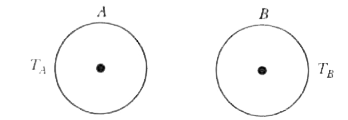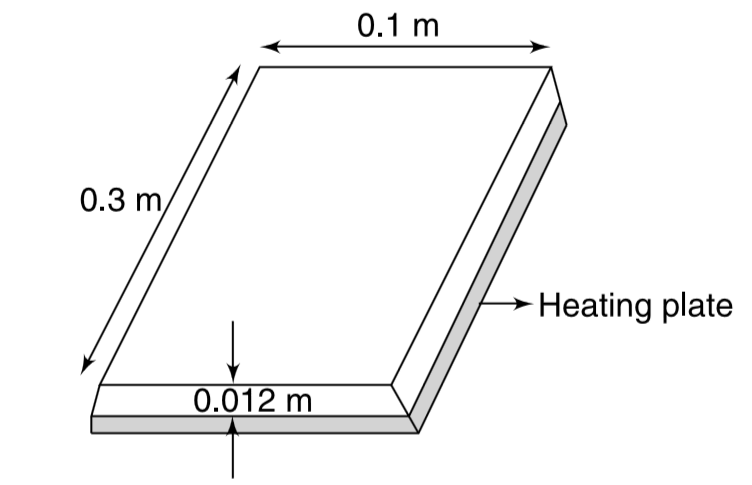
A and B are tqo isolated spheres kept in close proximity so that they can exchange energy by radiation. The two spheres have identical physical dimensions but the surface of A behaves like a perfactly black body while the surface of B reflects 20% of all the radiations it receives. They are isolated from all other sources of radiation.
If they are in thermal equilibrium and exchange equal amounts of radiation per second then they will be at same absolute temperature, TA=TB.
If they are in thermal equilibrium and exchange equal amounts of radiation per second then TA=(0.8)1/4TB.
If they are not in thermal equilibrium and are each at t=0 at the same temperature TA=TB=T, then the sphere A will lose thermal energy and B will gain thermal energy.
If they are not in thrmal equilibrium and are each at t=0 at the same temperature TA=TB=T, Then the sphere A will gain thermal energy and B will lose thermal energy.
The correct Answer is:A
Since they are in thermal equilibrium the temperatures must necessarily be equal. Temperature equality is a necessary and sufficient condition for thermal equilibrium (zeroth law of thermodynamics).
Topper's Solved these Questions
- CALORIMETRYBOOK - CENGAGE PHYSICSCHAPTER - CALORIMETRYEXERCISE - Multiple Correct
25 Videos
- CALORIMETRYBOOK - CENGAGE PHYSICSCHAPTER - CALORIMETRYEXERCISE - Comprehension
30 Videos
- CALORIMETRYBOOK - CENGAGE PHYSICSCHAPTER - CALORIMETRYEXERCISE - Subjective
25 Videos
- BASIC MATHEMATICSBOOK - CENGAGE PHYSICSCHAPTER - BASIC MATHEMATICSEXERCISE - Exercise 2.6
20 Videos
- CENTRE OF MASSBOOK - CENGAGE PHYSICSCHAPTER - CENTRE OF MASSEXERCISE - INTEGER_TYPE
1 Videos
Similar Questions
A and B are two isolated spheres kept in close proximity so that they can exchange energy by radiation as shown in the following figure. The two spheres ,have identical physical dimension, but the surface of A behaves like a perfectly black body while the surface of B reflects 20% of all the radiations it receives. They are isolated from all other sources of radiation.

View Solution(i) Two isolated metal spheres A and B have radii R and 2R respectively and same charge q. Find which of the two spheres have
(a) greater capacitance
(b) greater energy density just outside the surface of the spheres.
(ii) (a) Show that the equipotential surfaces are closed together in the regions of strong field and far apart in the region of weak field. Draw equipotential surfaces for an electric dipole.
(b) Concentric equipotential surfaces due to a charged body placed at the centre are shown. Identify the polarity of the charge and draw the electric field lines due to it.
View Solution
Knowledge Check
The spectra of all stars show a continuous spectrum like the solar spectrum, in which dark absorption lines are superimposed. The photosphere (inner layer of the star) emits radiations of all wavelengths, producing a continuous spectrum. On passing through the outer (comparatively cooler) layer of the star, radiations of certain wavelengths are selectively absorbed by this layer. This is the cause behind the dark lines in the star's spectrum. These dark lines are characteristics of the substances present in the outer layer of the star. For measuring the surface temperature of the star, we need to measure the wavelength at which the intensity of emitted radiation is maximum and then using Wien's displacement law, given below
λm=T=b where b is the Wien's constant and its experimentally determined value is 2.89×10−3mK
Which of the following options is true for spectrum of light received from a star?AContinuous emission spectrumBabsorption line spectrumCemission line spectrumDemission band spectrumAssertion: A hollow metallic container closed from all sides can act as a source of black body radiation if maintained at a certain temperature,
Reason: All metallic objects act as a black body.AIf both assertion and reason are correct and reason is a correct explanation of the assertion.BIf both assertion and reason are correct but reason is not the correct explanation of assertion.CIf assertion is correct but reason is incorrect.DIf assertion is incorrect but reason is correct.Two bodies A and B having equal surface areas are maintained at temperatures 10∘C . And 20∘C . The thermal radiation emitted in a given time by A and B are in the ratio
A1:1.15B1:02C1:04D1:16 .
A steel plate is 0.3m long, 0.1m wide and 0.012m thick. The plate is placed on a heating plate of identical size maintained at 100∘C. The heating plate is receiving energy through a 50 W heater. The heating plate losses heat only to the steel plate which is well insulated from all sides except at the top. The top surface of the steel plate is exposed to an airstream of temperature 20∘C. The top surface of the steel plate radiates like a black body. Calculate the rate at which the top surface looses heat due to convection. The surface of steel plate in contact with heating plate is at 100∘C. Thermal conductivity of steel k=16Wm−1K−1 Stefan’s constant =5.67×10−8Wm−2K−4

View SolutionTwo identical conduction spheres, one having an initial charge +Q and the other initially uncharged, are brought into contact.
(a) What is the new charge on each sphere?
(b) While the spheres are in contact, a positively chaged rod is moved close to one sphere, causing a redistribution of hte charges on the two spheres so the charge on hte sphere closest to the rod has a charge-Q. What is the charge to the other sphere?
View SolutionTwo identical conduction spheres, one having an initial charge +Q and the other initially uncharged, are brought into contact.
(a) What is the new charge on each sphere?
(b) While the spheres are in contact, a positively chaged rod is moved close to one sphere, causing a redistribution of hte charges on the two spheres so the charge on hte sphere closest to the rod has a charge-Q. What is the charge to the other sphere?
View SolutionIn a hexaonal system system of cycstals, a frequently encountered arrangement of atoms is described as a hexagonal prism. Here, the top and bottom of the cell are refular hexagons, and three atoms are sandwiched in between them. A space-cilling model of this structure, called hexagonal close-paked is constituted of a sphere on a flat surface surrounded in the same plane by six identical spheres as closely as possible. Three spherres are then placed overt the first layer so that they toych each other and represent the second layer so that they toych each other and present the second layer. Each one of the three spheres touches three spheres of the bottom layer. Finally, the second layer is convered with a third layer identical to the bottom layer in relative position. Assume the radius of every sphere to be r.
The empty space in this hcp unit cell is
(a)74%
(b)48.6%
(c)32%
(d)26%
View SolutionTwo bodies A and B having equal surface areas are maintained at temperatures 10∘C . And 20∘C . The thermal radiation emitted in a given time by A and B are in the ratio
View Solution
